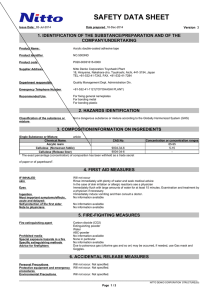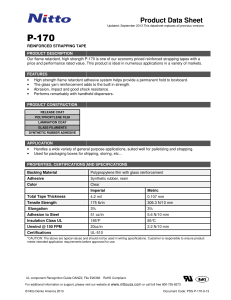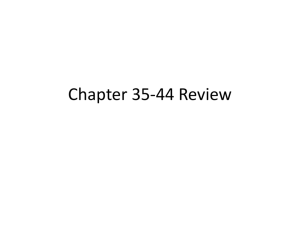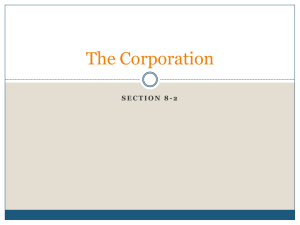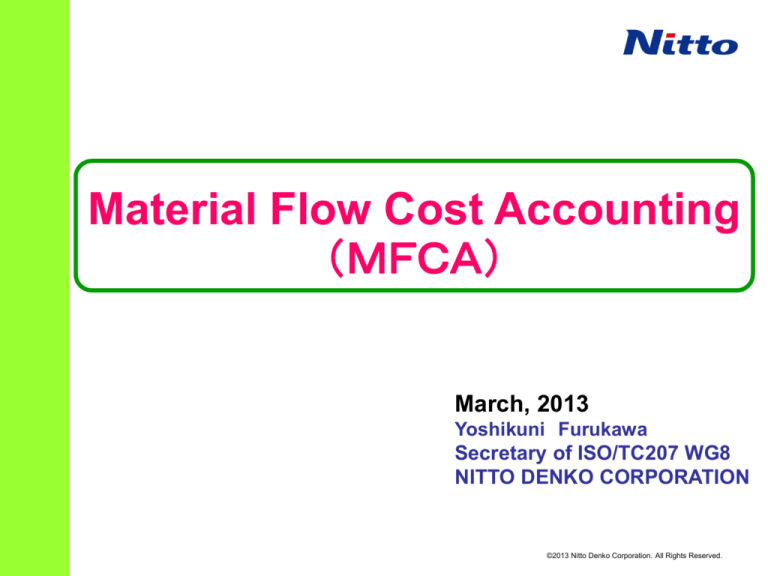
Material Flow Cost Accounting
(MFCA)
March, 2013
Yoshikuni Furukawa
Secretary of ISO/TC207 WG8
NITTO DENKO CORPORATION
©2013 Nitto Denko Corporation. All Rights Reserved.
Contents:
1. Introduction
2. Significance and Characteristics of
Material Flow Cost Accounting (MFCA)
3. MFCA vs. Conventional Cost Accounting
4. Implementation & Case Example of Nitto Denko
5. Implementation & Key Factor for Success
©2013 Nitto Denko Corporation. All Rights Reserved.
Introduction
Modern image of
environmental management
Traditional image of
environmental management
high
high
c
n re
i
e
eas
I ncr
costs
Re
rate
e
l
c
y
costs
d uc
tion
in
wa
ste
low
low
low
level of environmental
management
high
Costs increase in proportion to the
level of environmental management
low
level of environmental
management
high
Costs decrease in proportion to the
level of environmental management
©2013 Nitto Denko Corporation. All Rights Reserved.
Significance of Material Flow Cost Accounting
• MFCA focuses on emission (waste)
• Profit is hidden in emission (waste)
• MFCA finds out the hidden profit
INR
MFCA
Japanese “Mottainai” Concept,
“What a shame to be wasteful” in ISO
©2013 Nitto Denko Corporation. All Rights Reserved.
Benefits of MFCA
Internal benefits
Increasing
profit
Improving productivity
External benefits
Reducing
environmental impacts
Contributing to sustainable development
©2013 Nitto Denko Corporation. All Rights Reserved.
Conventional Cost Accounting
Inputs:
・Raw materials
- Quantity: 1,000 g
- Unit cost: $10/g
・Conversion cost:
- Process 1: $10,000
- Process 2: $15,000
Raw materials
1,000 g($10,000)
Conversion cost
$10,000
Finished products
Process 2
Process 1
Flow to finished
products
[Goods from Process 1]
- Raw materials
900 g, $10,000
- Conversion cost
$10,000
[Conversion cost]
$15,000
Total inputs
900 g, $35,000
Flow to finished
products
Raw materials
720 g, $10,000
Conversion cost
$25,000
Total
720 g, $35,000
Flow to emissions
Flow to emissions
Emissions (waste)
Emissions (waste)
Emissions (waste)
Raw materials
100 g, $0
Conversion cost
$0
,
Total
100 g, $0
Raw materials
180 g, $0
Conversion cost
$0
,
Total
180 g, $0
Raw materials
180 g, $0
Conversion cost
$0
,
Total
280 g, $0
©2013 Nitto Denko Corporation. All Rights Reserved.
Characteristics of MFCA
Process 1
Inputs:
・Raw materials
- Quantity: 1,000 g
- Unit cost: $10/g
・Conversion cost:
- Process 1: $10,000
- Process 2: $15,000
Raw materials
1,000 g($10,000)
Conversion cost
$10,000
Process 2
Flow to finished
products
[Goods from Process 1]
- Raw materials
900 g, $9,000
- Conversion cost
$9,000
[Conversion cost]
$15,000
Total inputs
900 g, $33,000
Finished products
Flow to finished
products
Raw materials
720 g, $7,200
Conversion cost
$19,200
Total
720 g, $26,400
Flow to emissions
Flow to emissions
Emissions (waste)
Emissions (waste)
Emissions (waste)
Raw materials
100 g, $1,000
Conversion cost
,
$1,000
Total
100 g, $2,000
Raw materials
180 g, $1,800
Conversion cost
,
$4,800
Total
180 g, $6,400
Raw materials
280 g, $2,800
Conversion cost
,
$5,800
Total
280 g, $8,600
©2013 Nitto Denko Corporation. All Rights Reserved.
MFCA vs. Conventional Cost Accounting
Inputs
・Raw materials
- Quantity: 1,000 g
- Unit cost: $10/g
- Cost of materials:
$10,000
・Conversion cost:
- Process 1: $10,000
- Process 2: $15,000
Total: $35,000
Outputs
Conventional
cost accounting
Flow to finished products
Raw materials: 720 g ($10,000)
Conversion cost: $25,000
Total: $35,000
Raw materials: 280 g ($0)
Conversion cost: $0
Flow to emissions
MFCA
Flow to finished products
Total: $0
Raw materials: 720 g ($7,200)
Conversion cost: $19,200
Total: $26,400
Raw materials: 280 g ($2,800)
Conversion cost: $5,800
Flow to emissions
Total: $8,600
©2013 Nitto Denko Corporation. All Rights Reserved.
Implementation of MFCA
Cost Elements
1. Material: Input Value of Material
2. Energy: Input Value of Energy
3. System: Labor, Depreciation and etc.,
4. Disposal (Waste Management Cost):
©2013 Nitto Denko Corporation. All Rights Reserved.
Material Flow Cost Accounting (Flow Model)
©2013 Nitto Denko Corporation. All Rights Reserved.
“Material” Flow Chart with Data
Product: Adhesive Tapes for Electronics Application
Quantity: 912pcs.
Period: one month (Nov. 01-30, 2000), (JPY1.80/INR )
Dissolution etc.,
Coating & Drying
Store
Flow to Product
Flow to Waste
Product
Slitting etc.,
2,474.39㎏
22,144.50㎡
27,404.00㎡
306.83㎏
21,714.15㎡
24,761.75㎡
SI:
127.58㎏
9,028.80㎡
10,296.00㎡
351.01㎏
24,840.60㎡
28,327.00㎡
247.87㎏
17,541.50㎡
17,541.50㎡
¥177,431.12
¥1,165,500.00
¥1,264,800.00
¥65,009.62
¥1,142,850.00
¥1,142,850.00
EI:
83.40㎏
5,902.35㎡
6,730.75㎡
¥74,370.26
¥1,307,400.00
¥1,307,400.00
¥52,517.47
¥923,236.82
¥809,607.68
Core etc¥714,582.22
(¥2,499,944.19)
SI:
¥27,031.58
¥475,200.00
¥475,200.00
Waste:
86.27㎏
430.35㎡
2,642.25㎡
EI:
¥17,670.94
¥310,650.00
¥310,650.00
68%
<Total Waste>
Waste:
103.14㎏
7,299.10㎡
10,785.50㎡
Waste:
Solvent Gases 1,981.29㎏
Solvent Gases 1,981.29㎏
Waste:
¥13,357.00
¥22,,650.00
¥121,950.00
Waste: ¥21,852.79
¥384,163.18
¥497,792.32
29%
Solvent Gases ¥99,064.50
289.41㎏
7,729.45㎡
13,427.75㎡
Top: Adhesive(Red)
Middle: Backing Film(Blue)
Bottom: Separator(Green)
3%
Waste: ¥35,209.79
¥406,813.18
¥619,742.32
(¥1,061,765.29)
Solvent Gases ¥99,064.50
©2013 Nitto Denko Corporation. All Rights Reserved.
Allocation Method of “Energy and System Cost”
Cost Elements
Allocation Base
Allocation Type
Energy (electricity)
Consumption
B
Energy (fuel)
Consumption
B
Labor (legular employee)
Man-hour
A
Labor (part-timer)
Man-hour
A
Operating time
B
Maintenances
Expenditure
C
Tools and Implements
Expenditure
C
Depreciation
(straight-line method)
A : Allocation on base of real data
B : Allocation on base of monthly data (correctly as possible)
C : Apportionment on base of monthly data
©2013 Nitto Denko Corporation. All Rights Reserved.
Result of Material Flow Cost Accounting
Period: from November 01 to 30, 2000 (Unit: JPY ), (JPY1.80/INR )
Cost
Material
Energy
System
Disposal
Total
Product
2,499,944
(68.29%)
57,354
(68.29%)
480,200
(68.29%)
N/A
3,037,498
(67.17%)
Material
loss
1,160,830
(31.71%)
26,632
(31.71%)
222,978
(31.71%)
74,030
(100%)
1,484,470
(32.83%)
Total
3,660,774
(100%)
83,986
(100%)
703,178
(100%)
74,030
(100%)
4,521,968
912pcs
(100%)
©2013 Nitto Denko Corporation. All Rights Reserved.
12
Comparison of P/L
Period: from November 01 to 30, 2000 (Unit: JPY) , (JPY1.80/INR)
Material Flow P/L (Unit: Yen)
Sales*
Cost of
Product
Cost of
Material loss
Gross Profit
Selling, General
and Administrative
Expenses*
Operating Profit
*Provisional Figure
Conventional P/L (Unit: Yen)
15,000,000 Sales*
3,037,498 Cost of Sales
1,484,470 N/A
10,478,032 Gross Profit
8,000,000
2,478,032
Selling, General and
Administrative
Expenses*
Operating Profit
15,000,000
4,521,968
N/A
10,478,032
8,000,000
2,478,032
©2013 Nitto Denko Corporation. All Rights Reserved.
Decision Making Flow (1)
Input value of Material Loss and input value of Product
are clarified in each Quantity Center.
The Material Loss Analysis in each Production Process
Implemented Countermeasure to reduce Material loss
Increase of profit and reduction of environmental impact
©2013 Nitto Denko Corporation. All Rights Reserved.
Decision Making Flow (2)
Material Loss Analysis
1. Theoretical/ Design Loss:
Machine Design, Solvent Medium, Edge of Jumbo Roll, etc
2. Normal Loss:
Set-up, Trial Running, Cleaning, Sample, etc
3.Avoidable/Abnormal Loss:
Poor Workmanship, Spoilage, Defective Unit, etc
©2013 Nitto Denko Corporation. All Rights Reserved.
Implemented Countermeasure
Loss Analysis
S
Improvement for Winding Roller
Change of Slitter
Change of Slitting Timing
Task Force Team Activities
R
Q
P
O
N
Change of Coating Width
Change of Separator Width
Ageing Condition of Jumbo Roll
Improvement for Jumbo Roll Rewinding
M
L
K
J
I
H
Improvement for Extruding Machine
Up-Grade Pigment
Up-Grade Base Resin
G
F
E
D
Packing Improvement for Materials
Cleaning of Base Film Edge
Others
C
B
A
0.00%
5.00%
10.00%
15.00%
20.00%
25.00%
30.00%
35.00%
40.00%
New Investment
©2013 Nitto Denko Corporation. All Rights Reserved.
The cause of losses need to be examined from a perspective of supply chain.
It is important to trace upstream the cause of losses (e.g. Upper processes, Materials, suppliers)
Recovery, Refinement, Deodorizing Furnace
Suppliers
③
Two of
materials (Unit: Kg)
Solvent, Polymer
Solvent Gases
(100%)
Four of materials
(Unit: Kg)
-Solvent
-Monomer
-Crosslinker A
-Crosslinker B
Gas emissions
Two of materials
(Unit: Width x Length)
(1) Backing Films:
570mm width
(2) Separator:
650mm width
Auxiliary materials
Packaging materials
Energy
(1) Steam, Thermal
(2) Electric power
One of material:
Plastic core (Unit: Piece)
Energy: Electric power
¥541,681.52
Materials
¥72,936.90
¥104,494.22
Dissolution
②
Two of materials
(Unit: Kg)
Solvent, Polymer
①
Coating & Drying
Batch Blend
Waste
Waste
¥13,357.00
Energy cost: \83,986
(Dissolution, Batch blend, Coating & Drying,
Slitting & Inspection and Packaging)
Store
Slitting
Waste:
Backing film:
¥22,650
Separator:
¥121,950
Adhesive:
¥13,357
Inspection &
Packing
Each size of product
(Width x Length)
Waste
¥22,650.00
¥121,950.00
Manufacturing
Division
¥923,236.82
¥809,607.68
¥52,517.47
¥1,307,400.00
¥1,307,400.00
¥74,370.26
Upper quantity
center
Adhesive
Mass (Unit:
Kg)
¥172,900.70
¥384,163.18
¥497,792.32
¥21,852.79
Waste: out of Jumbo Roll
Backing film: ¥384,163.18
Separator: ¥497,792.32
Adhesive:
¥21,852.79
Finished Product:
Adhesive tapes for
Electronics
Application
Quantity: 912 rolls
Warehouse
Finished Products(912 rolls)
Backing film:
¥923,236.82
Separator:
¥809,607.68
A dhesive:
¥52, 517. 47
Plastic core:
¥541,681.52
Packaging materials:¥172,900.70
Total
¥2,499,944.19
The cause of losses does not
always lie in the quantity
center where they occurred
©2013 Nitto Denko Corporation. All Rights Reserved.
Headline of major Japanese
Newspaper:
-Nitto Denko and MFCA
-Invested ”seven hundred
million JPY”, based on MFCA
- Reducing Costs
- Firstly in Japan
(Note:JPY1.80/INR)
©2013 Nitto Denko Corporation. All Rights Reserved.
What is ignored in Conventional Cost Accounting
Standard cost (including allowable losses)
Cost of finished product
Avoidable/
abnormal
loss
Normal
loss
Theoretical
Design loss
The scope of improvement target in standard costing
Ignored
The scope of improvement target in MFCA
Cost of finished product
Cost of waste
©2013 Nitto Denko Corporation. All Rights Reserved.
Mass Balance vs. Yield Ratio
D=A+C = Input
Adhesive compound
Sheet
Coated width
C:Normal loss,
Theoretical
loss
(e.g. trial loss,
idling loss )
A:Length of Master roll
B:Master roll
(goods completed)
G:Edges of roll(Normal loss and Theoritical loss)
F:Defective loss
Cut
E:Finished
products
B:Master roll
(goods completed)
Yield rate
=
4 tapes (E)
5 tapes (E+F)
=
80%
©2013 Nitto Denko Corporation. All Rights Reserved.
MFCA and PDCA Cycle
Determine the applicable product
and boundary
Make the flow cost matrix
Set up the material flow model
Analyze material flow data
(loss analysis and process analysis)
Establish quantity centers
Collect material flow data
Repeat
this cycle
Plan measures to solve problems
Decide data collection methods
Implement measures planned
Determine allocation methods of
energy and system cost
Collect material flow data
Cost reduction and lowered
environmental impacts
©2013 Nitto Denko Corporation. All Rights Reserved.
Improvement
2001
2004
Cost
2012
(Latest)
Product
67%
78%
93%
Material
Loss
33%
22%
7%
100%
100%
100%
Total
©2013 Nitto Denko Corporation. All Rights Reserved.
Example of Key Factor for Success(1)
High
Degree of the
accuracy of
data
Cost (man-hours)
and
degree of the
accuracy of data
Cost
Reasonable
level
low
small
Number of the established
quantity center
large
©2013 Nitto Denko Corporation. All Rights Reserved.
Example of Key Factor for Success (2)
Priority of Countermeasure:
1. Avoidable/Abnormal Loss:
Poor Workmanship, Spoilage, Defective Unit , etc
2. Normal Loss:
Set-up, Trial Running, Cleaning, (Sample), etc
3. Theoretical/ Design Loss:
©2013 Nitto Denko Corporation. All Rights Reserved.
External Benefits
Environmental Impacts
1. Reduction of industrial waste
2. Reduction of CO2 emission
©2013 Nitto Denko Corporation. All Rights Reserved.
Improvement
Unit: Ton CO2, one product only
Cost
2001
2004
2011
Product
136.8
136.8
136.8
Material
Loss
73.2
66.0
(-7.2)
210.0
202.8
58.8
(-14.4)
195.6
Total
©2013 Nitto Denko Corporation. All Rights Reserved.
Conclusion of MFCA
MFCA grasps the cost of material loss for each production process
製造工程単位に廃棄物原価(負の製品)を把握
MFCA is like
a CT scanner that provides clearer picture of manufacturing processes
産廃原価はレントゲン、マテリアルフローコスト会計はCTスキャン
どの製造工程の改善に人とお金を投入すべきか
It helps to determine the priority of process improvement
優先順位が明確になる
The improved performance will be made clear as
改善効果は「負の製品阻止額(新しい概念)」
“savings from curtailing material losses”
Necessary information for implementation is often
現行の会計システムを変えるものではない
already in a site
It enables companies to cut costs and reduce environmental impact
simultaneously
©2013 Nitto Denko Corporation. All Rights Reserved.

